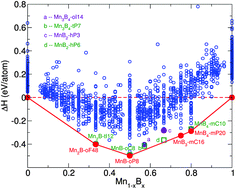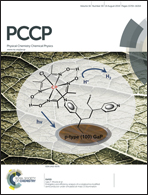Variable-composition structural optimization and experimental verification of MnB3 and MnB4
Abstract
In combination with variable-composition evolutionary algorithm calculations and first-principles calculations, we have systematically searched for all the stable compounds and their crystal structures in the extensively investigated binary Mn–B system. Our results have uncovered four viable ground-state compounds, with Mn2B, MnB, and MnB4, and previously never reported MnB3 and two metastable compounds, MnB2 and Mn3B4. Our calculations demonstrate that the early characterized mC10 structure of MnB4 showed dynamic instability with large imaginary phonon frequencies and, instead, a new mP20 structure is predicted to be stable both dynamically and thermodynamically, with a considerable energy gain and no imaginary phonon frequencies. The new MnB3 compound crystallizes in the monoclinic mC16 structure which lies 3.2 meV per atom below the MnB (oP8) ↔ MnB4 (mP20) tie-line at T = 0 K. Furthermore, these proposed phases have been verified by our annealed samples after arc-melting synthesis and corresponding powder XRD measurements.


 Please wait while we load your content...
Please wait while we load your content...